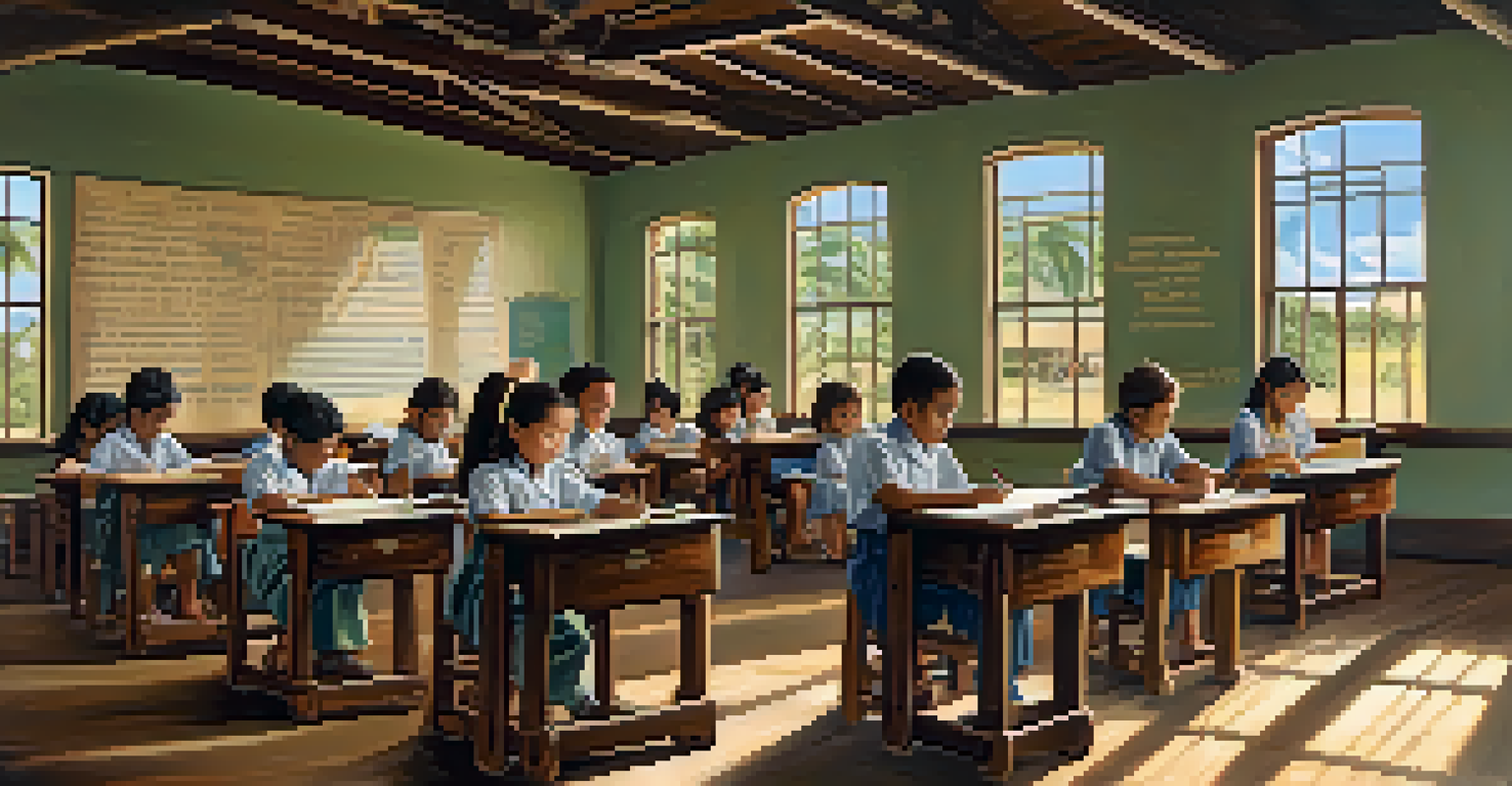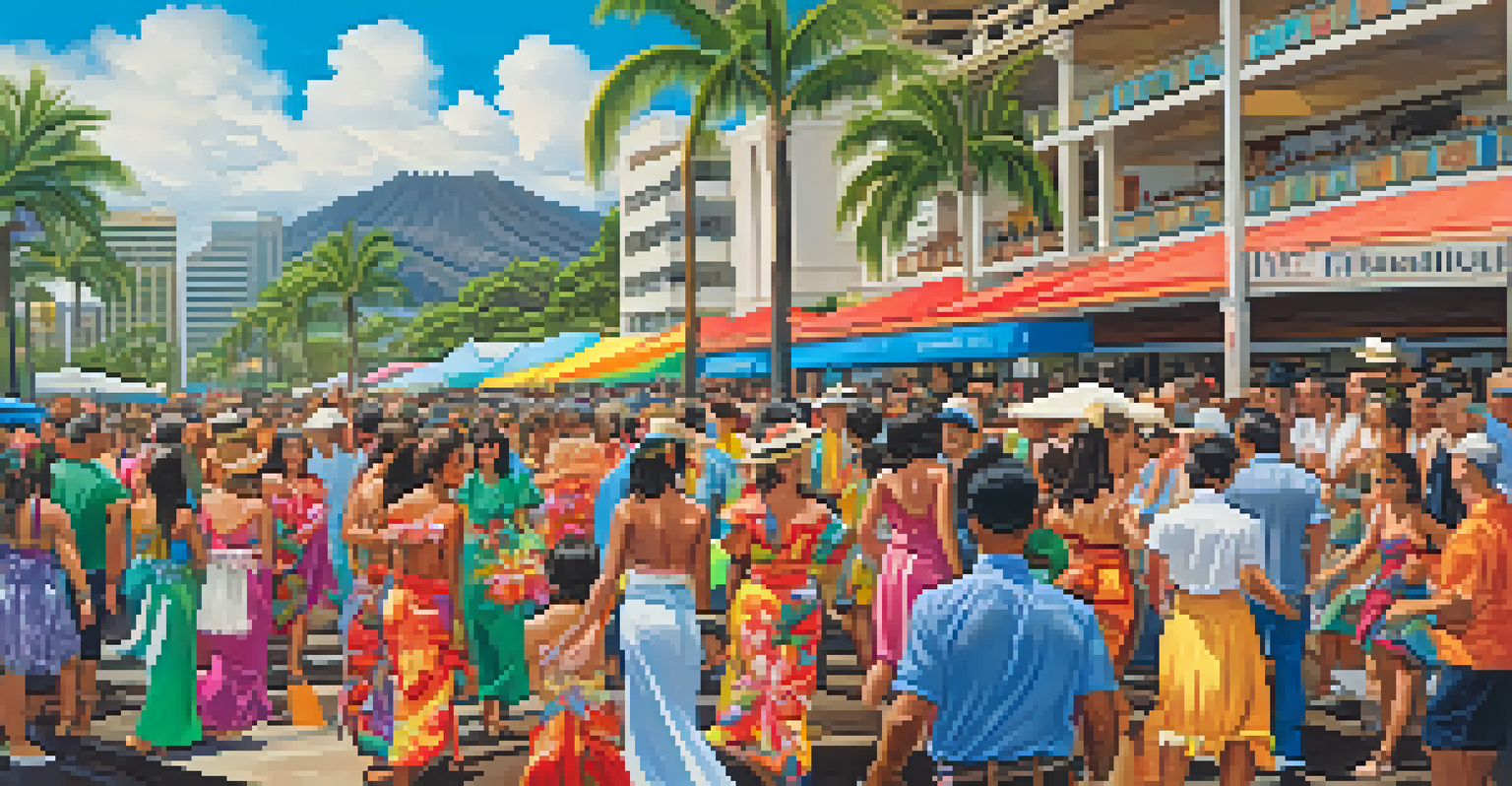The Influence of Missionaries on Honolulu's Development

The Arrival of Missionaries in Hawaii
In the early 19th century, American missionaries arrived in Hawaii, motivated by a desire to spread Christianity. Their journey marked the beginning of a significant cultural transformation in the islands, particularly in Honolulu. These missionaries were not just religious leaders; they were also educators and advocates for social change, bringing with them new ideas and practices.
The missionaries' arrival initiated a dialogue between Hawaiian traditions and Western practices, a theme that would recur throughout Hawaii's history.
Upon their arrival, they quickly established schools and churches, laying the foundation for educational and spiritual development. This effort was more than just evangelism; it was about integrating Western values into Hawaiian society. The missionaries recognized the unique challenges of the local culture and aimed to build bridges rather than erect barriers.
As they settled in, the missionaries began to influence local governance, which would later shape Honolulu's political landscape. Their presence initiated a dialogue between Hawaiian traditions and Western practices, a theme that would recur throughout Hawaii's history. This interplay set the stage for Honolulu's eventual growth into a bustling urban center.
Educational Advancements Initiated by Missionaries
One of the most significant contributions of missionaries was the establishment of a formal education system in Hawaii. They founded schools that taught reading, writing, and arithmetic, making education accessible to the local population. This effort was revolutionary at the time and laid the groundwork for an educated society.

Missionaries translated the Bible and other texts into Hawaiian, fostering literacy and encouraging the use of the Hawaiian language. This linguistic effort not only empowered the local community but also preserved Hawaiian culture during a time of rapid change. The ability to read and write became a crucial skill, opening doors for many native Hawaiians.
Missionaries Transformed Education
American missionaries established a formal education system in Hawaii, significantly increasing literacy and fostering a foundation for an educated society.
As education expanded, so did opportunities for social mobility. The schools became hubs of learning that taught not just academics but also moral values and civic responsibility. This holistic approach contributed significantly to the development of Honolulu's community and governance.
Cultural Changes Brought by Missionaries
The missionaries' arrival also led to profound cultural shifts in Honolulu. With their teachings, new religious practices emerged, often blending with traditional Hawaiian beliefs. This syncretism created a unique cultural landscape that reflected both indigenous and Western influences.
Understanding this nuanced history is key to appreciating the present and future of Honolulu.
Additionally, missionaries introduced Western customs, including new forms of music, art, and public celebrations. These changes influenced local traditions and led to the creation of a hybrid culture that remains evident in Honolulu today. The fusion of different cultural elements enriched the community and enhanced its diversity.
However, these cultural changes were not without contention. Many native Hawaiians struggled with the loss of traditional practices and beliefs, leading to a complex relationship with the missionaries. This tension highlighted the challenges of cultural integration and the balance between preservation and innovation.
Economic Development and Missionary Influence
Missionaries played a pivotal role in transforming Honolulu's economy. They encouraged agricultural practices and introduced new crops, which helped diversify the local economy. This agricultural shift allowed for the growth of trade, connecting Honolulu with global markets.
The introduction of sugarcane plantations was a direct result of missionary influence, as they sought to create a sustainable economic model for the islands. This led to an influx of labor and capital, further accelerating Honolulu's development into a commercial hub. The sugar industry became a cornerstone of Hawaii's economy, attracting immigrants and investors alike.
Cultural Fusion in Honolulu
The arrival of missionaries led to a blend of Western customs with traditional Hawaiian practices, creating a unique cultural landscape still evident today.
As the economy flourished, so did the city's infrastructure. Missionaries advocated for the construction of roads, bridges, and ports, enhancing Honolulu's connectivity and accessibility. This development not only improved trade but also facilitated communication and interaction among the islands.
Political Influence of Missionaries in Honolulu
The missionaries' impact extended into the political realm as well, shaping governance in Honolulu. Many of them became influential figures in local politics, advocating for laws and policies that reflected their values. Their involvement helped lay the groundwork for a new political structure, blending traditional Hawaiian leadership with Western governance.
As Hawaii evolved, so did the political landscape, with missionaries often at the forefront of significant changes. They supported constitutional reforms and the establishment of a more organized government, which aimed to modernize the islands. This transition was crucial in positioning Honolulu as a key player in regional politics.
However, this newfound political power came with its own set of challenges. The missionaries' influence sometimes clashed with the interests of native Hawaiians, leading to tensions that would shape the islands' future. This ongoing struggle for power and representation continues to be a significant part of Hawaiian history.
The Legacy of Missionaries in Modern Honolulu
Today, the legacy of missionaries can be seen throughout Honolulu, from its educational institutions to its cultural practices. Many schools still reflect the educational foundations laid by these early missionaries, emphasizing both academic excellence and moral values. This enduring influence is a testament to their commitment to the community.
Culturally, the blend of Western and Hawaiian traditions continues to thrive in Honolulu. Festivals, music, and art often showcase this unique fusion, celebrating the city's diverse heritage. The missionaries' efforts to promote the Hawaiian language have also led to a resurgence of interest in native culture.
Economic Growth Through Agriculture
Missionaries influenced the economy by introducing new agricultural practices and crops, which helped Honolulu evolve into a commercial hub.
However, it's essential to recognize the complexities of this legacy. While missionaries contributed significantly to Honolulu's development, their arrival also initiated challenges that affected the native population. Understanding this nuanced history is key to appreciating the present and future of Honolulu.
Reflections on the Missionary Era
Reflecting on the era of missionaries in Honolulu reveals a tapestry of influence that shaped the islands' trajectory. Their commitment to education, economic development, and cultural integration left an indelible mark on the community. However, this impact came with contradictions and challenges that continue to resonate today.
As we examine the past, it's vital to consider both the positive contributions and the cultural dissonance that arose from missionary activity. This balanced perspective allows for a deeper understanding of Hawaii's history and the ongoing journey toward reconciliation and cultural appreciation.

Ultimately, the missionaries' story is one of transformation—both for the islands and their people. By acknowledging the complexities of their influence, we can honor the rich history of Honolulu and pave the way for a future that embraces all its diverse narratives.